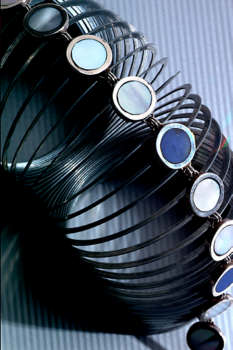The Basic Techniques of Shell Inlay
To learn the art of inlay, its best to start with the basics. This project will walk you through the fundamentals so that you become comfortable enough to move on to a more challenging project. Once you master this simple circular design, youll be setting stones and shells in plaques of various shapes and sizes in no time!.
6 Minute Read
The unknown is always mysterious, and sometimes unfamiliar territory looks downright scary. Of course, looks can be deceiving. Inlay - the art of cutting stones or shells to fit snugly within the recesses of a setting - may seem difficult at first, but it's actually pretty easy to learn.
The Basic Techniques of Shell Inlay
Most of us have seen and admired the beautiful inlay created by Native American artists. They cut and polish the stones, then arrange them in plaques (recesses defined by thick-walled bezels). The plaques themselves have intriguing shapes, depicting animals, geometric forms, and even landscapes. Almost any type of stone or other hard, organic material can be used for inlay, but the most common materials are turquoise, coral, onyx, and mother-of-pearl shell. The results can be stunning.
To learn the art of inlay, it's best to start with the basics. This project will walk you through the fundamentals so that you become comfortable enough to move on to a more challenging project. Once you master this simple circular design, you'll be setting stones and shells in plaques of various shapes and sizes in no time!
Materials
- Sterling-silver wire: 8- to 10-gauge, square
- Sterling-silver wire: 18- to 20-gauge, round
- Sterling-silver sheet: 20- to 22-gauge
- Mother-of-pearl shell
- Jump rings
- Clasp
Tools & Supplies
|
|
Time Saver
If you're long on creativity but short on time, here's a short-cut to help you achieve the best of both worlds. Design and fabricate one link of your bracelet, and send it out to a casting service. The casting service will make silicone molds of your link, inject wax into the molds, then proceed with a method called "lost wax casting," where molten metal takes the place of the wax piece. When you receive the castings, they will need a little filing, sanding, and polishing, but that's all.
Besides saving time, casting also ensures that each one is identical to the others. Check for casting companies in your local phone directory under "jewelry" or "casting," or search the Internet.
Technicolor Settings
When setting stones or other objects, the color of the plaque's interior often affects the stone's appearance, depending on the type of stone. Black coloration beneath mother-of-pearl shell gives the shell's surface a gray, blue, and purple haze. You can produce a fine, black coloring pigment by rubbing a wooden dowel against a charcoal stick. Grate the charcoal powder directly into your epoxy, and mix it in. You can also use this technique by grating colored pastels into your epoxy. Coat the lining of your plaque with the colored adhesive, then set your stone, shell, or other object.
Before you create a colorful mess experimenting with colored epoxies, try different color and stone combinations using colored paper or fabric. Temporarily place the material inside the setting, place a piece of dental floss across the opening (as a removal tool), and press the stone in to see how the color affects the stone's appearance.
Safety First
Dust produced when cutting, grinding, polishing, or drilling shells and stones can be hard on your lungs. A particulate respirator should be worn when undertaking heavy-duty production work, or if you're particularly sensitive to dust. It's also a good idea to protect your eyes with safety goggles. Always keep the grinding wheels and stone or shell wet to reduce airborne dust, keep the work cool, and prevent the wheels from clogging. Water is the most common coolant used.
You assume all responsibility and risk for the use of the safety resources available on or through this web page. The International Gem Society LLC does not assume any liability for the materials, information and opinions provided on, or available through, this web page. No advice or information provided by this website shall create any warranty. Reliance on such advice, information or the content of this web page is solely at your own risk, including without limitation any safety guidelines, resources or precautions, or any other information related to safety that may be available on or through this web page. The International Gem Society LLC disclaims any liability for injury, death or damages resulting from the use thereof.
The All-In-One Jewelry Making Solution At Your Fingertips
When you join the Ganoksin community, you get the tools you need to take your work to the next level.
Trusted Jewelry Making Information & Techniques
Sign up to receive the latest articles, techniques, and inspirations with our free newsletter.
